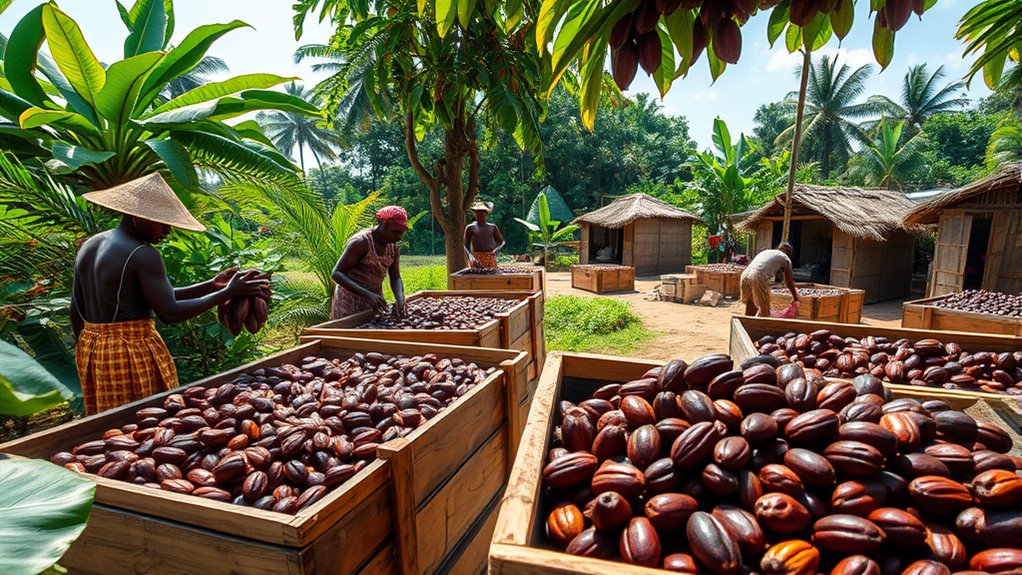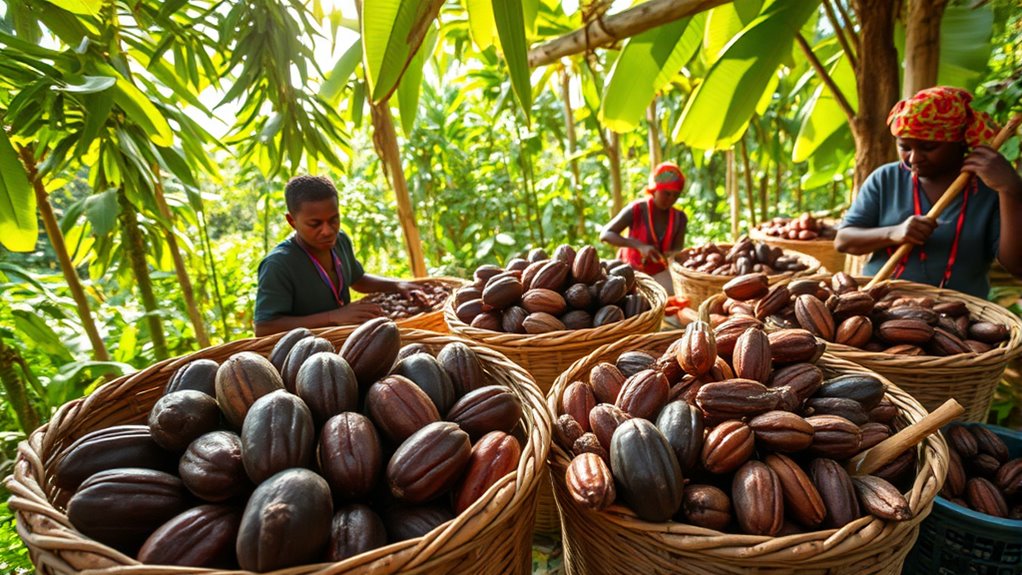To trace cocoa fermentation in Ghana, you start from harvesting ripe pods and carefully extracting beans. Then, beans are placed in shallow boxes or crates, where microbes like yeasts and bacteria activate, creating heat and converting sugars into acids. Proper turning and monitoring guarantee consistent fermentation, shaping the beans’ flavor. This essential process develops the rich, vibrant taste for Ghanaian chocolate—continue exploring to see how each step influences the final flavor profile.
Key Takeaways
- Monitoring fermentation duration, temperature, and turning practices ensures traceability from cocoa pod to flavor development.
- Proper fermentation transforms sugars into acids, influencing the final flavor profile of Ghanaian cocoa.
- Microbial activity during fermentation is key to flavor complexity and can be traced through fermentation conditions.
- Documenting fermentation techniques helps trace the journey from freshly harvested beans to the distinctive Ghanaian chocolate flavor.
- Consistent fermentation management minimizes off-flavors, ensuring high-quality cocoa from pod to final product.

Cocoa fermentation is a critical step that shapes the quality and flavor of Ghana’s renowned chocolate. When you start with fresh cocoa pods, the journey from bean to bar hinges on how effectively the fermentation process is managed. Fermentation techniques vary across regions and farms, but their goal remains the same: to develop the beans’ complex flavors and reduce bitterness. As you observe the process, you’ll notice that cocoa beans are typically placed in shallow boxes, covered with banana leaves, or sometimes fermented in wooden crates. These methods are designed to promote consistent heat and airflow, essential for unleashing optimal fermentation. The process usually lasts between 5 to 7 days, during which microbial activity transforms the beans chemically and biologically.
During fermentation, the natural sugars in the beans are converted into alcohols and acids, laying the foundation for flavor development. The microbes—yeasts, bacteria, and molds—work in tandem, generating heat that can reach up to 50°C (122°F). You’ll see that the temperature and duration are carefully monitored because they directly influence the beans’ final taste. Proper fermentation techniques guarantee that unwanted flavors are minimized, and desirable fruity, floral, or nutty notes begin to emerge. If the fermentation is too short or uneven, it can result in a flat or harsh flavor profile, whereas over-fermentation might lead to sourness or off-flavors.
Fermentation transforms sugars into flavor-rich acids, with careful temperature control shaping the final cocoa taste.
As you witness the process unfold, you might also notice the importance of turning the beans regularly. This helps maintain even fermentation, securing all beans are exposed to the right conditions. The fermentation environment’s humidity and temperature are critical, affecting microbial activity and, consequently, flavor development. Skilled farmers and fermenters understand the nuances of their specific techniques, adjusting parameters as needed to produce the best beans. The result of a well-managed fermentation is a batch of cocoa with a balanced aroma, vibrant flavor profile, and reduced bitterness—all essential qualities for premium chocolate.
In essence, fermentation techniques serve as the backbone of flavor development in Ghanaian cocoa. This stage not only detoxifies the beans but also accesses their full potential, setting the stage for the next phases of drying, roasting, and conching. When you trace cocoa from pod to flavor, understanding the intricacies of fermentation reveals the craftsmanship behind each bar of Ghanaian chocolate, showcasing how careful attention to this step shapes the sensory experience for consumers worldwide.
Frequently Asked Questions
How Does Cocoa Fermentation Influence Ghanaian Chocolate Quality?
You see, cocoa fermentation considerably influences Ghanaian chocolate quality by activating fermentation enzymes that break down pulp and develop flavor precursors. Microbial diversity during fermentation introduces unique strains that enhance aroma and taste. When these processes are well-managed, they produce beans with complex flavors, improving the final chocolate’s quality. So, the fermentation process directly shapes the richness and stability of Ghanaian chocolate, making it more appealing and distinctive.
What Traditional Methods Are Used in Ghanaian Cocoa Fermentation?
Oh, you think Ghanaian farmers just toss beans into fancy machines? Nope! They stick to their roots with traditional practices, using fermentation containers like wooden boxes or baskets. These simple fermentation containers help develop flavor naturally, relying on age-old techniques passed down generations. It’s a dance of patience and tradition, where each container and method plays a essential role in crafting that rich, authentic Ghanaian cocoa flavor.
How Do Local Ghanaian Practices Affect Cocoa Flavor Profiles?
You can see that traditional fermentation and cultural influence shape Ghanaian cocoa’s unique flavor profiles. Local practices, like specific fermentation durations and methods, impact the beans’ acidity, sweetness, and aroma. These cultural traditions preserve authentic flavors, giving Ghanaian cocoa its distinct character. Your appreciation deepens as you understand how these traditional techniques, passed down through generations, directly influence the quality and taste of the final chocolate.
What Environmental Factors Impact Cocoa Fermentation in Ghana?
You’re really digging into the heart of cocoa fermentation’s environmental influences. When soil moisture levels are just right, fermentation thrives, but too dry or wet hampers it. Ambient temperature plays a vital role too; warmth accelerates fermentation, while cooler temperatures slow it down. The saying “a stitch in time saves nine” reminds you to monitor these factors closely, as they directly shape the cocoa’s flavor profile and overall quality in Ghana.
How Can Fermentation Techniques Be Improved for Better Flavor Consistency?
To improve fermentation techniques for better flavor consistency, you should focus on fermentation monitoring and microbial management. By regularly checking temperature, pH, and fermentation progress, you can guarantee ideal conditions. Managing microbial populations through inoculation or controlled environment adjustments helps produce uniform flavors. Consistent techniques, combined with precise monitoring, enable you to achieve high-quality, flavorful cocoa batches, meeting market demands and enhancing your product’s reputation.
Conclusion
Now that you’ve seen the journey from pod to flavor, you realize how essential fermentation is to Ghana’s cocoa. Each step shapes the rich taste you love, proving that good things come to those who wait. By understanding this process, you appreciate the craft behind every bean. Remember, you can’t judge a book by its cover—just like cocoa, true flavor lies deep within, waiting to be uncovered.










